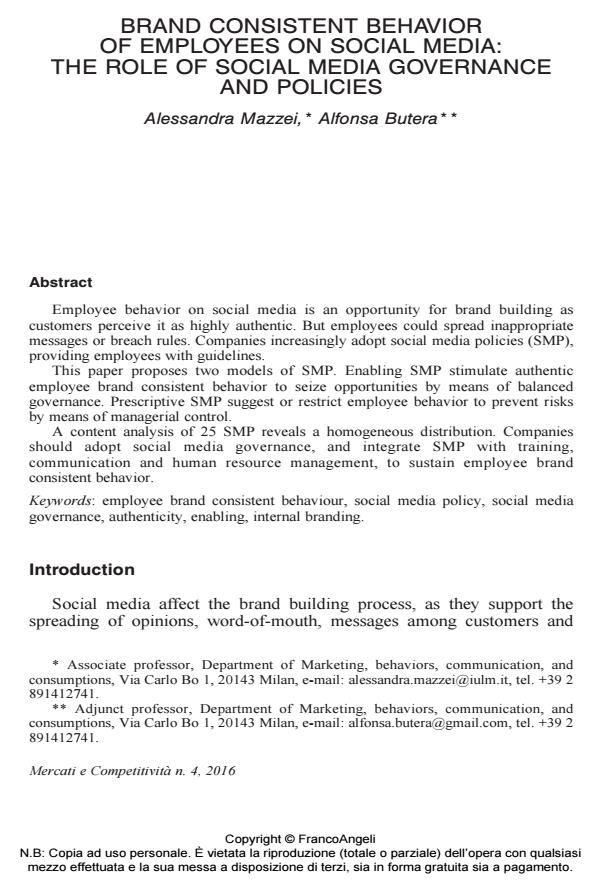Brand consistent behavior of employees on social media: the role of social media governance and policies
Titolo Rivista MERCATI & COMPETITIVITÀ
Autori/Curatori Alessandra Mazzei, Alfonsa Butera
Anno di pubblicazione 2016 Fascicolo 2016/4
Lingua Inglese Numero pagine 22 P. 85-106 Dimensione file 140 KB
DOI 10.3280/MC2016-004006
Il DOI è il codice a barre della proprietà intellettuale: per saperne di più
clicca qui
Qui sotto puoi vedere in anteprima la prima pagina di questo articolo.
Se questo articolo ti interessa, lo puoi acquistare (e scaricare in formato pdf) seguendo le facili indicazioni per acquistare il download credit. Acquista Download Credits per scaricare questo Articolo in formato PDF

FrancoAngeli è membro della Publishers International Linking Association, Inc (PILA)associazione indipendente e non profit per facilitare (attraverso i servizi tecnologici implementati da CrossRef.org) l’accesso degli studiosi ai contenuti digitali nelle pubblicazioni professionali e scientifiche
Employee behavior on social media is an opportunity for brand building as customers perceive it as highly authentic. But employees could spread inappropriate messages or breach rules. Companies increasingly adopt social media policies (SMP), providing employees with guidelines. This paper proposes two models of SMP. Enabling SMP stimulate authentic employee brand consistent behavior to seize opportunities by means of balanced governance. Prescriptive SMP suggest or restrict employee behavior to prevent risks by means of managerial control. A content analysis of 25 SMP reveals a homogeneous distribution. Companies should adopt social media governance, and integrate SMP with training, communication and human resource management, to sustain employee brand consistent behavior.
Parole chiave:Employee brand consistent behaviour, social media policy, social media governance, authenticity, enabling, internal branding
- Using a Digital Internal Communication Strategy for Digital Capability Development Lucia Wuersch, Alain Neher, Jane F. Maley, Marc K. Peter, in International Journal of Strategic Communication /2024 pp.167
DOI: 10.1080/1553118X.2024.2330405 - Current Trends and Issues in Internal Communication Alessandra Mazzei, Alfonsa Butera, pp.165 (ISBN:978-3-030-78212-2)
- Firm policies and employees’ participation in conversation about their employer on social media Barbara Del Bosco, Alice Mazzucchelli, Roberto Chierici, in Italian Journal of Marketing /2023 pp.301
DOI: 10.1007/s43039-023-00074-3 - Digital transformation of work: Swiss MSEs working from home behaviour during COVID-19 – pioneers leading the pack Marc K. Peter, Lucia Wuersch, Alfred Wong, Alain Neher, in European Business Review /2024 pp.249
DOI: 10.1108/EBR-01-2023-0008
Alessandra Mazzei, Alfonsa Butera, Brand consistent behavior of employees on social media: the role of social media governance and policies in "MERCATI & COMPETITIVITÀ" 4/2016, pp 85-106, DOI: 10.3280/MC2016-004006